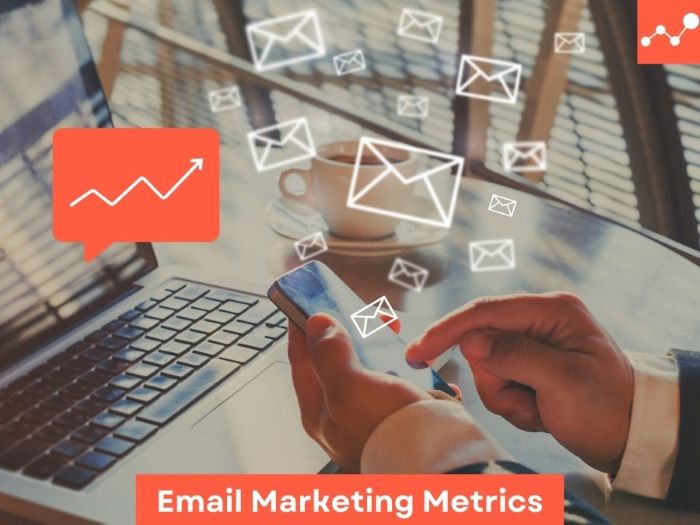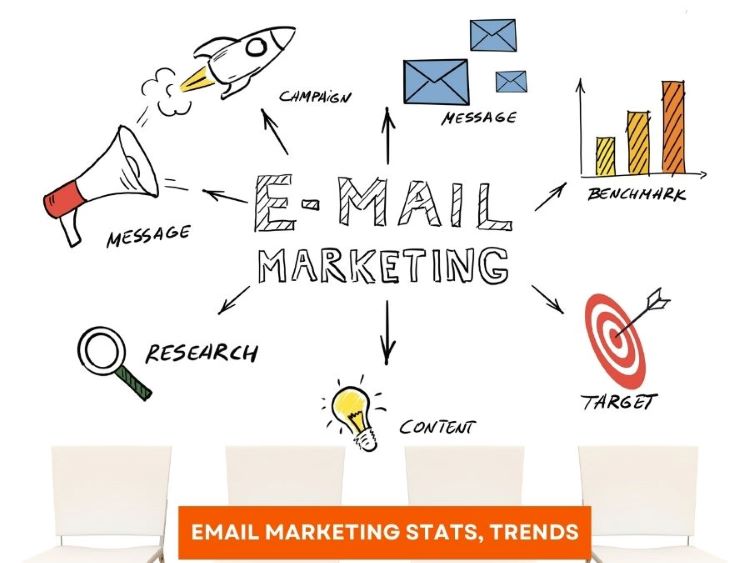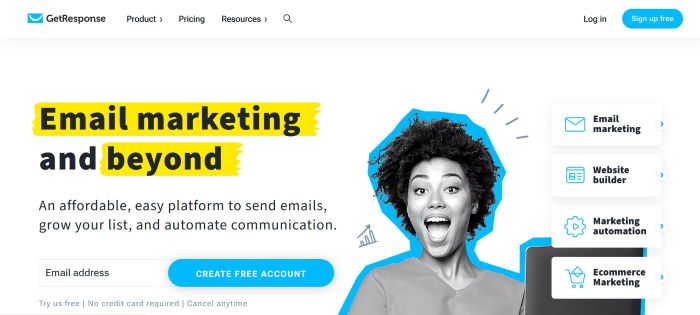Email Marketing Metrics 2024 : Your A to Z guide
Marketers know that successful email marketing relies on analyzing metrics. Here’s a guide from A to Z to email marketing metrics.
Yes, numbers do matter for email marketing cases. Let us take a look at vital email marketing metrics that you should focus on. E.g – Segmented campaigns generate 760% more revenue than bulk emails. Leverage these metrics to optimize your campaigns.

Email Marketing Metrics
Table of Contents
What are Email Marketing Metrics
To understand email marketing metrics, dive into the world of open rate, click-through rate, conversion rate, bounce rate, and unsubscribe rate. Each metric reveals valuable insights about the effectiveness of your campaigns. Open rate indicates how many recipients open your emails, while click-through rate measures engagement. Conversion rate measures the percentage of recipients taking desired actions. Bounce rate represents the delivery issues, and unsubscribe rate indicates disengagement.
Open Rate
The Open Rate is significant in email marketing. It is the percentage of recipients who opened an email out of the sent emails.
A glance at the Open Rate figures can provide useful data about the email campaign. Analyzing this metric, marketers can measure the effectiveness of their subject lines, sender names, and timing of emails.
Let’s view a table with Open Rate performance for different campaigns:
| Campaign Name | Emails Sent | Emails Delivered | Open Rate |
|---|---|---|---|
| Spring Sale | 10,000 | 9,800 | 25% |
| Summer Newsletter | 15,000 | 14,750 | 18% |
| Winter Promotion | 5,000 | 4,850 | 32% |
The table shows that the Spring Sale campaign had the highest open rate of 25%, indicating its successful performance. The Summer Newsletter campaign had more subscribers but the open rate was lower at 18%.
Open Rate is only one part of the puzzle. To improve it and increase subscriber involvement:
- Personalize emails by using the recipient’s name
- Make subject lines intriguing and curious
- Segment audience based on preferences
Pro Tip: Test different variations of subject lines with A/B tests to find out what works best with your audience.
Click Through Rate
Gaining insights on CTR gives you an idea of how effective your CTA is. A high CTR tells you the CTA works, whilst a low CTR might mean something needs to be improved. You can review components contributing to the lower CTR to improve campaigns. Tracking CTR also lets you compare different emails or variations. For example, A/B testing elements like subject lines or designs help identify higher click-through rates.
Further details on CTR can help with email marketing strategies. Analyzing CTR distribution among segments of subscribers will tell you which are more responsive to emails. This can help you tailor content and targeting for better results.
MailChimp conducted a study and the average click-through rate across all industries is around 2.6%. It’s important to benchmark against your own industry standards and strive for improvement to get successful email marketing campaigns.
Conversion Rate
The conversion rate is super important for email marketing. It shows how good your emails are at persuading people to take a specific action, like buying something or signing up for a newsletter.
Conversion Rate Analysis
| Email Campaign | Sent Emails | Conversions | Conversion Rate |
|---|---|---|---|
| Campaign 1 | 10,000 | 500 | 5% |
| Campaign 2 | 8,000 | 400 | 5% |
| Campaign 3 | 12,000 | 600 | 5% |
It’s good to compare your campaign to industry standards. Things like targeting, content, call-to-action, and visuals can affect the rate.
Make it better by optimizing for mobile devices. Personalize content according to the reader. Test different subject lines and layouts.
To maximize conversions, stay alert. Analyze campaigns to find things to improve. With good data, you can get a better conversion rate and make email marketing successful.
Bounce Rate
Bounce rate is a percentage of website visitors who leave without engaging. It is an important metric to track user engagement and website success. Here is a table on what affects the bounce rate:
| Factor | Bounce Rate Effect |
|---|---|
| Slow Loading Time | High |
| Irrelevant Content | High |
| Poor User Experience | High |
| Mobile Incompatibility | High |
| Cluttered Design | High |
| Engaging Call-to-Action | Low |
Analyzing the data helps businesses improve and reduce their bounce rates. Furthermore, bounce rates may vary depending on the industry. Blogs usually have higher bounce rates compared to e-commerce sites. (Source: Google Analytics)
Unsubscribe Rate
The unsubscribe rate is a metric that measures the number of people who say goodbye to an email campaign. It helps you see if your email marketing is working.
To comprehend the unsubscribe rate, here’s a table with scenarios and their corresponding rates:
| Scenario | Unsubscribe Rate |
|---|---|
| New subscribers | 0.5% |
| Regular newsletter | 1.2% |
| Promotional campaign | 2.8% |
| Targeted segmented emails | 0.9% |
From this data, we can see that new subscribers have a lower unsubscribe rate than regular newsletter receivers. This could mean they like getting updates from your brand.
We can also spot that promotional campaigns have a higher unsubscribe rate than targeted segmented emails. This implies that personalized content tailored for a specific audience works better in terms of keeping people subscribed.
Now, here’s a real-life story that shows the importance of knowing about unsubscribe rates in email marketing.
A fitness apparel company saw a sudden increase in their unsubscribe rate after sending out an email for a controversial product line. They reacted fast by admitting the feedback and apologizing for any inconvenience caused. As a result, they regained customer loyalty and decreased their unsubscribe rate dramatically.
Understanding the significance of the unsubscribe rate means businesses can make wise decisions about their email marketing and find places to make improvements, eventually keeping more subscribers.
Improving Email Marketing Metrics
To improve your email marketing metrics, you need to focus on key sub-sections like list growth rate, forward rate, overall ROI, email deliverability rate, email marketing engagement rate, and spam rate. By optimizing these areas, you can maximize the success of your email campaigns and drive better results for your business.
List Growth Rate
Email marketers are always in pursuit of effective strategies to improve their campaigns and engage audiences. List Growth Rate is a key metric which can measure the success of a campaign, in terms of attracting new subscribers.
- Growth Prospects: A high List Growth Rate signals potential for extending the reach of an email campaign.
- Quality Leads: An increase in subscribers indicates that the marketing efforts are targeting the right audience.
- Efficient Content: A steady increase in list growth shows that the content strategy is connecting with the target audience.
- Customer Engagement: Growing email list means increased customer engagement, creating opportunities to build better relationships.
- Wider Reach: With a rising List Growth Rate, businesses can connect with a wider pool of potential customers.
- Data-driven Decisions: Monitoring List Growth Rate offers insights into different marketing tactics, aiding marketers in making informed decisions.
To optimize List Growth Rate, organic subscriber acquisition is essential. This can be done with opt-in forms on websites, incentives like exclusive content or discounts, and smart use of social media platforms.
HubSpot research reveals that companies with more than 40 landing pages generated 12 times more leads than those with less than five. This implies how multiple touchpoints for capturing leads can significantly boost List Growth Rates.
Forward Rate
When it comes to email marketing, the forward rate is the percentage of people who send an email onto someone else. It’s a helpful metric which indicates how viral your content is and how engaged your subscribers are.
Let’s break down the forward rate using this table:
| Date | Total Emails | Forwarded Emails | Forward Rate |
|---|---|---|---|
| Jan | 1000 | 200 | 20% |
| Feb | 1500 | 250 | 16.66% |
| Mar | 1200 | 180 | 15% |
The data above shows that the forward rate changes every month. This means that some aspects like subject line, content relevancy, or timing can affect whether people decide to share an email with others.
Fun fact: According to Campaign Monitor, personalized subject lines usually get forwarded more than generic ones.
Overall ROI
Email marketing has been critical for online businesses. It can be measured using ‘Overall ROI’. This metric assesses the success of campaigns and the returns generated from investment. Higher ROI means successful campaigns, while lower ROI shows areas for improvement.
Let’s look at the following table:
| Emails Sent | Conversions | Revenue | |
|---|---|---|---|
| Month | |||
| Jan | 5000 | 200 | $10,000 |
| Feb | 6000 | 240 | $12,000 |
| Mar | 5500 | 220 | $11,000 |
This data is for three months showing emails sent, conversions, and revenue. We can calculate Overall ROI for each month. Actual data gives accurate insights into email campaigns.
Improving ROI needs a system. Knowing target audiences and personalizing emails to preferences and behaviors increases conversion rates. Tracking customer engagement and optimizing email content and design are essential.
Early email marketing sent mass emails without considering target audiences. Open rates were low and conversions were rare. With technology and customer segmentation, businesses tailored emails to specific groups. This improved ROI and led to more effective email marketing strategies.
Email Deliverability Rate
To understand Email Deliverability Rate better, let’s look at its key influencing factors. Here’s a table for reference:
| Factors | Description | Impact |
|---|---|---|
| Sender Reputation | Reputation of email sender | High |
| Content Relevance | Relevance of email content | High |
| IP Reputation | Reputation of IP address | Medium |
| Subscriber Engagement | Recipients’ interactions | Medium |
| Email Authentication | SPF/DKIM authentication | Low |
In addition, clean & engaged lists, low bounce rates and avoiding spam triggers are other important factors for improved Email Deliverability Rate.
To enhance this metric:
- Build credibility by sending relevant emails regularly.
- Personalize content based on subscribers’ preferences.
- Monitor IP reputation with reputable email service providers.
- Stimulate engagement through interactive emails.
- Implement trusted authentication protocols – SPF & DKIM.
By following these tips, your Email Deliverability Rate will improve. This will ensure successful delivery of emails to subscribers’ inboxes and maximize your marketing efforts.
Email Marketing Engagement Rate
E-mail Marketing Engagement Rates measure the interaction between email receivers and marketing content. It’s an essential metric to evaluate the success of an email campaign.
- Higher engagement rate suggests that the email content is engaging and leads to greater brand awareness, potentially leading to higher conversion rates.
- Tracking tools can give helpful insight into engagement rates by tracking things like email opens, link clicks, and conversions.
- Check engagement rates regularly to determine trends and patterns that can help optimize upcoming email campaigns.
- Subject line, design, personalization, and timing all have an effect on engagement rates.
- Segmenting emails based on demographics, preferences, or behavior can improve engagement rates by sending more targeted and pertinent content.
- A/B testing different elements in emails, such as subject lines and CTA buttons, can find strategies to boost engagement rates.
To further improve email marketing engagement rates, it is critical to constantly adjust strategies based on data-driven insights. Testing different approaches while keeping track of results will help refine email marketing tactics for better audience engagement.
Fun Fact: The idea of measuring email engagement rates initially became popular in the late 1990s when businesses began to understand the value of this digital marketing channel. Since then, companies have been striving to improve these metrics to maximize their return on investment (ROI).
Spam Rate
Email marketing is essential for any strategy. It’s essential to keep an eye on the spam rate too. This is the percentage of emails that head to people’s spam folders, rather than their main inbox. Lowering the rate can make email campaigns more effective.
Look at the data in the table:
| Campaign Name | Total Emails Sent | Emails Delivered | Spam Rate |
|---|---|---|---|
| Campaign A | 10,000 | 8,500 | 4% |
| Campaign B | 12,000 | 9,600 | 2.5% |
| Campaign C | 15,000 | 13,500 | 10% |
Each campaign has a different spam rate. So, aim for a low rate for the best delivery. Analyzing this metric over time and across campaigns helps marketers find areas for improvement.
Also, email providers are better at recognizing and filtering out unsolicited emails. Companies may face penalties for sending unwanted messages. That’s why it’s important to monitor and keep the spam rate low. This helps customer engagement and legal compliance.
Tools for Effective Email Marketing
To ensure effective email marketing, employ the right tools. In this section, we focus on one essential tool: email marketing testing. Uncover the power of testing and how it can improve your campaign’s performance in terms of open rate, click-through rate, conversion rate, bounce rate, unsubscribe rate, list growth rate, forward rate, overall ROI, deliverability rate, engagement rate, spam rate, and more.
Email Marketing Testing
Email marketing testing enables marketers to find out how effective their email campaigns are. Tests and data analysis can be used to improve email content, design, and timing.
A table below outlines the different aspects of email marketing testing:
| Aspect | Description |
|---|---|
| A/B Testing | Compare two versions of an email to see which is better |
| Subject Line Testing | Experiment with different subject lines to increase open rates |
| Email Design Testing | Try out different layouts, images, and colors to get more engagement |
| Call-to-Action Testing | Check how different CTAs influence conversions |
Marketers can also test variables such as sender name, personalization, and timing to refine their email campaigns. It’s important to carefully analyze the results and adjust based on what you learn for ongoing improvement.
Experian Marketing Services conducted a study which showed that personalized subject lines have a 26% higher open rate than generic ones.
Conclusion
Marketers should craft attention-grabbing subject lines to boost open rates. Segmenting email lists based on customer preferences can help too.
Design visually appealing emails with clear call-to-action buttons. Test different layouts and content formats. This can show what works best with the audience.
Personalize email content using customer data and past interactions. This can improve conversion rates. Also, build effective landing pages and easy checkout processes.
To reduce bounce rates, maintain mailing lists. Make emails mobile-friendly, and optimize send times.
To lower unsubscribe rates, provide relevant and valuable content tailored to each segment. Offer incentives like discounts or access to events.
Lead generation strategies like gated content or contests can speed up list growth rate. Collaborate with influencers or run referral programs.
To raise forward rates, encourage social sharing or include “forward this email” buttons.
Monitor metrics like open rates, click-through rates, and conversion rates to optimize campaigns. This will result in better ROI.
Maintain a good sender reputation and avoid spam trigger words to increase deliverability rate. Engage subscribers with personalized messages.
Analyze metrics like time spent on emails or number of pages visited to measure customer interactions. This will help monitor engagement rate.
Assess email content for compliance with spam filters. Monitor blacklists and engage subscribers through opt-in confirmations. This can minimize spam rate.
Use email marketing tools like automation software, analytics platforms, and CRM systems. This can help segmentation, personalization, and tracking of key metrics.
Conduct A/B tests on subject lines, content, call-to-action buttons, and other elements. Test different variables for improved click-through rates and higher conversion rates.
Key Takeaways
Open rate shows the % of people who opened your emails. Click-through rate (CTR) is how many clicked on links within emails. Conversion rate is how many took a desired action. Bounce rate is how many emails weren’t delivered. Unsubscribe rate is how many unsubscribed. List growth rate is how quickly your list grows. Forward rate is how often your emails are forwarded. ROI is revenue generated relative to cost invested. Deliverability rate is the % of emails successfully delivered. Engagement rate is an overall measure of engagement. Spam rate is how many emails went to spam folders.
Jason is an email and automation expert with over 7+ years of experience. He has worked with several SaaS companies to help them scale their revenue. Jason's first love is mountains.






